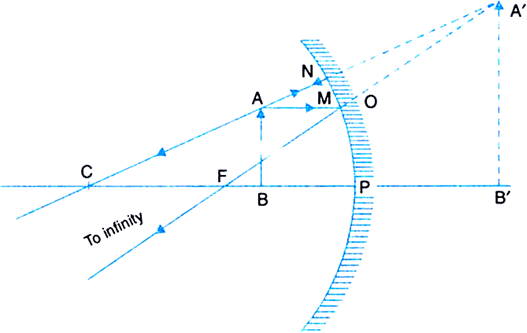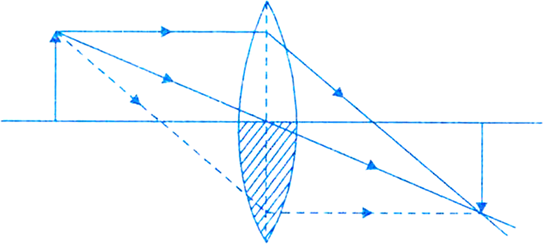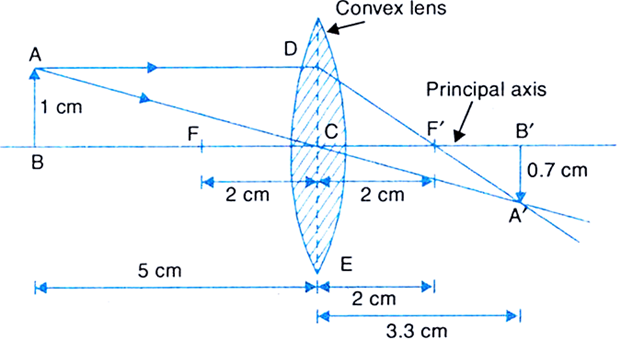
A convex lens of focal length 5 cm
C.
A convex lens of focal length 5 cm

One-half of a convex lens is covered with a black paper. Will this lens produce a complete image of the object? Verify your answer experimentally. Explain your observations.
As shown in Fig, when the lower half the convex lens is covered with a black paper, it still forms the complete image of the object as that with uncovered lens. But the intensity of the image is reduced when one half the convex lens is covered with a black paper.
(a) Concave mirrors are used as reflectors in headlights of cars. The bulb is located at the focus of the concave mirror and so, the light rays after reflection from the mirror travel over a large distance as a parallel beam of high intensity.
(b) A convex mirror is used as a side/rear-view mirror of a vehicle because of the following reasons:
(i) A convex mirror always forms an erect, virtual and diminished image of an object placed anywhere in front of it.
(ii) A convex mirror has a wider field of view than a plane mirror of the same size and haence, covers a wider field of area.
(c) Large concave mirrors are used to concentrate sunlight to produce heat in solar furnaces. Concave mirrors are converging mirrors.
Converging lens means a convex lens. As the distances given in the question are large, so we choose a scale of 1: 5, i.e., 1 cm represents 5 cm. Therefore, on this scale 5 cm high object, object distance of 25 cm and focal length of 10 cm can be represented by 1 cm high, 5 cm and 2 cm lines respectively. Now, we draw the ray diagram as follows:
(i) Draw a horizontal line to represent the principal axis of the convex lens.
(ii) Centre line is shown by DE.
(iii) Mark two foci F and F' on two sides of the lens, each at a distance of 2 cm from the lens.
(iv) Draw an arrow AB of height 1 cm on the left side of lens at a distance of 5 cm from the lens.
(v) Draw a line AD parallel to principal axis and then, allow it to pass straight through the focus (F') on the right side of the lens.
(vi) Draw a line from A to C (centre of the lens), which goes straight without deviation.
(vii) Let the two lines starting from A meet at A'.
(viii) Draw AB', perpendicular to the principal axis from A'.
(ix) Now AB', represents the real, but inverted image of the object AB.
(x) Then, measure CB' and A'B'. It is found that CB' = 3.3 cm and A'B' = 0.7 cm.
(xi) Thus the final position, nature and size of the image A'B' are:
(a) Position of image A'B' = 3.3 cm × 5 = 16.5 cm from the lens on opposite side.
(b) Nature of image A’B’: Real and inverted.
(c) Height of image A'B': 0.7 × 5 = 3.5 cm, i.e., image is smaller than the object.
